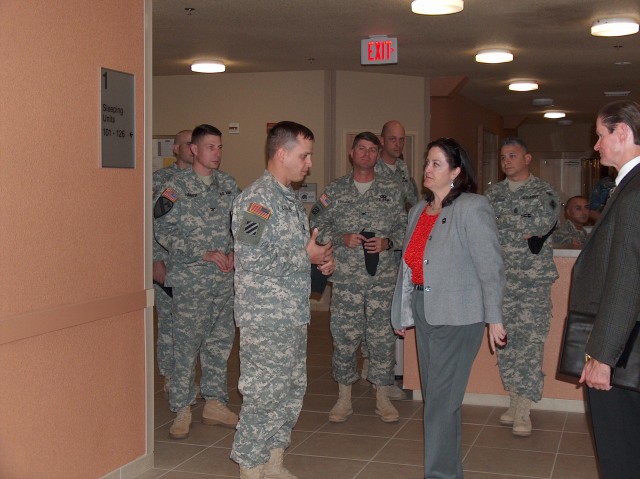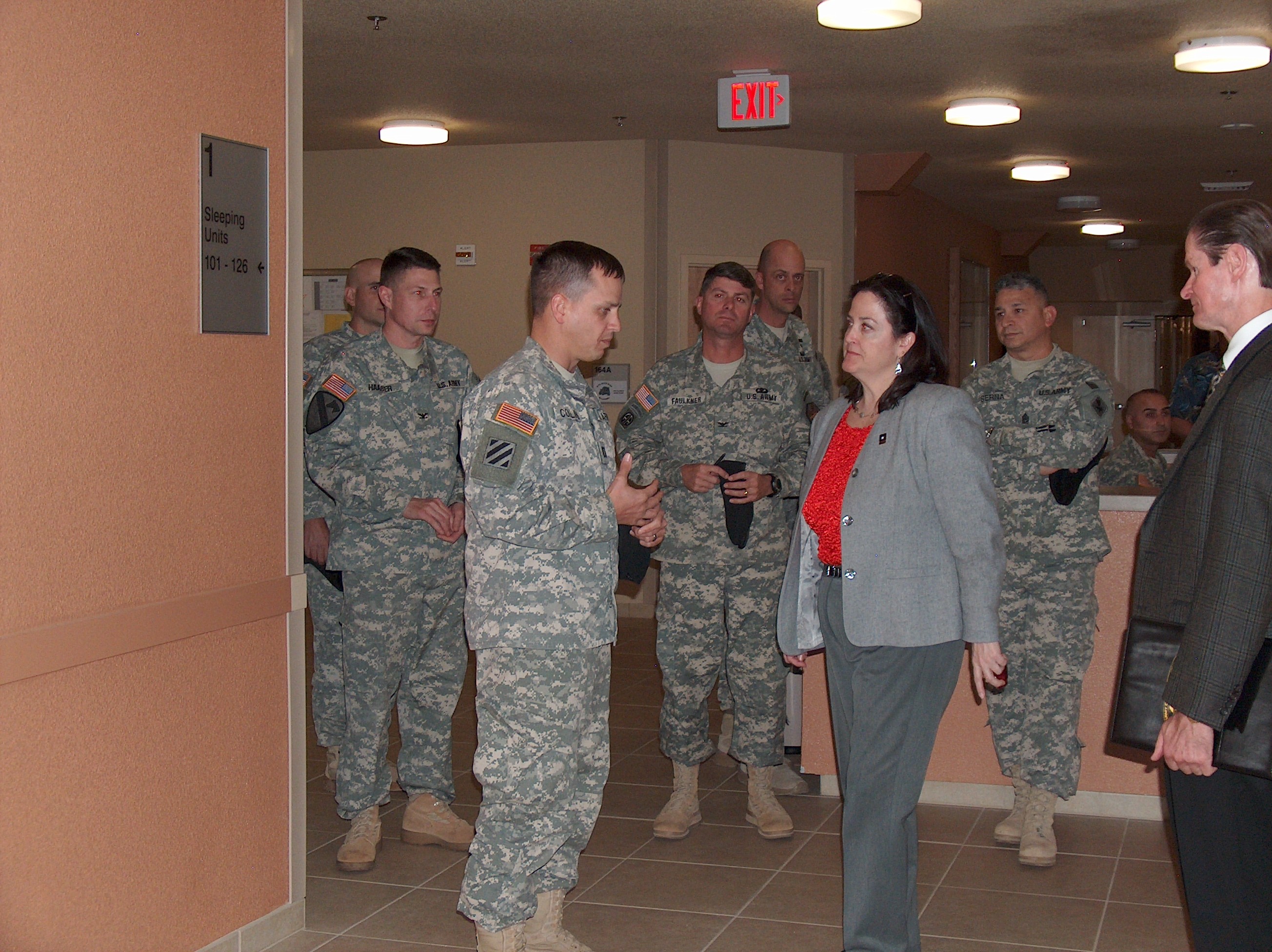
FORT HUACHUCA, Ariz. -- The Honorable Katherine Hammack, Assistant Secretary of the Army for Installations, Energy and Environment, visited Fort Huachuca Friday for a personal look at the installation, energy and water initiatives here supporting Army sustainability and net-zero goals.
"The goal is net-zero," Hammack said, with net-zero being a combination of energy, water and waste. "The key is to generate as much energy on an installation as you use; reduce the amount of water that is used and balance use with reuse; and reduce waste that is generated through recycling, reuse and repurposing, maybe even energy generation from waste so you don't have disposal.
"As the military, we would much rather use our lands for other purposes than digging a hole and throwing trash in it," she added. "We'd like to use it for playgrounds and training grounds, barracks and vehicle maintenance."
Hammack is the primary advisor to the Secretary and Chief of Staff of the Army on all Army matters related to installation policy oversight and coordination of energy security and management. She is also responsible for policy and oversight of sustainability, environmental initiatives and resource management.
Following an aerial tour of the installation Friday morning, Hammack met with Maj. Gen. John Custer, commanding general, U.S. Army Intelligence Center of Excellence, and was then provided an overview briefing of the installation's initiatives and challenges by garrison and Electronic Proving Ground staff.
Gretchen Kent, director of the Plans, Analysis and Integration Office, stressed the fact that Fort Huachuca has surpassed its water conservation goals by employing multiple strategies in conservation, reuse, recharge and conservation easements. Total water savings add up to 3,000 acre-feet per year, almost 1 billion gallons, with an associated energy cost avoidance of more than $3 million in fiscal year 2010.
Fort Huachuca has been able to reduce groundwater pumping by more than 60 percent on post since 1989 and received the White House Closing the Circle Award for Sustainability in 2003 for its water management system.
"Net-zero water is something this installation has been focusing on for many years," Hammack said. "So the amount of water you pump out is balanced against the amount of water you capture and use to recharge the aquifers. So therefore you're appropriately managing the resources at your disposal."
Water saving methods and technologies employed on the installation include an irrigation policy, waterless urinals, artificial turf, treated effluent irrigation of the golf course and storm-water recharge among others. In a comparison of consumptive water use in Arizona, Fort Huachuca comes in at 70 gallons per capita per day as compared to 220 gallons per capita per day in Phoenix.
Col. Timothy Faulkner, garrison commander, commended the partnerships the Fort has with the surrounding communities, including the Water Wise and Energy Smart program with the University of Arizona Cooperative Extension and the Upper San Pedro Partnership.
Beyond water, the fort's energy conservation strategies have resulted in a continued decrease in per capita energy use despite a 22 percent mission growth since 2007.
Energy projects like solar pool heating, solar parking lot lights, solar domestic hot water systems and solatubes skylights in post housing units directly impact the fort's goal to reduce energy consumption by 3 percent per year, putting Fort Huachuca on track for meeting or exceeding its goal of being a site net-zero post by 2025.
"Solar is certainly one of the strategies that is especially viable for Arizona with the amount of sun that is available here," Hammack agreed. "But solar is one of the strategies in a net-zero energy strategy. You first have to reduce the amount of energy you use.
"At this installation, there are a lot of great examples."
As Fort Huachuca and the Army also look at wind energy generation, the fort has become a test bed to determine potential mission impacts or shielding requirements for large wind turbines.
"There are a lot of questions surrounding wind turbines," Hammack said.
"What hasn't been done is the green analysis from an electro-magnetic aspect," said Thomas Roxberry, operations director of the Electronic Proving Ground. "The testing being conducted at Fort Huachuca will permit the Army to analyze and understand the impact commercial scale wind turbines have on Army C4ISR (Command, Control, Communications, Computers, Intelligence, Surveillance and Reconnaissance) and network equipment, where it is appropriate to site these on Army installations, and if possible, identify and develop mitigating measures if green electro-magnetic interference is encountered during training or a deployment."
Following the briefing, Hammack was able to see first-hand some of the sustainability initiatives employed on Fort Huachuca at Barnes Field House, privatized housing and Weinstein Village, among others.
"I was impressed that [Weinstein Village] is using thermal storage," Hammack said. "That's a great cooperation or partnership with the local utility and community so that at night when the utility has excess energy ... this facility uses the energy to make ice and chill water so that during the day when you need more energy for air conditioning you then are pumping that cold ice water out which reduces your overall energy usage."
In addition to sustainability initiatives, Hammack's tour highlighted the Education Center on Fort Huachuca where 1,200 students take 4,000 college courses each year. The Military Occupational Specialty credentialing program here helped more than 5,707 Soldiers complete 45,821 college courses earning 132,425 credit hours toward their degree completion in the last fiscal year. Another highlight included the Military Personnel Office and its online appointment system for Common Access Cards developed here which has reduced the Army standard of a 45-minute processing time to less than 15 minutes at Fort Huachuca.

Social Sharing